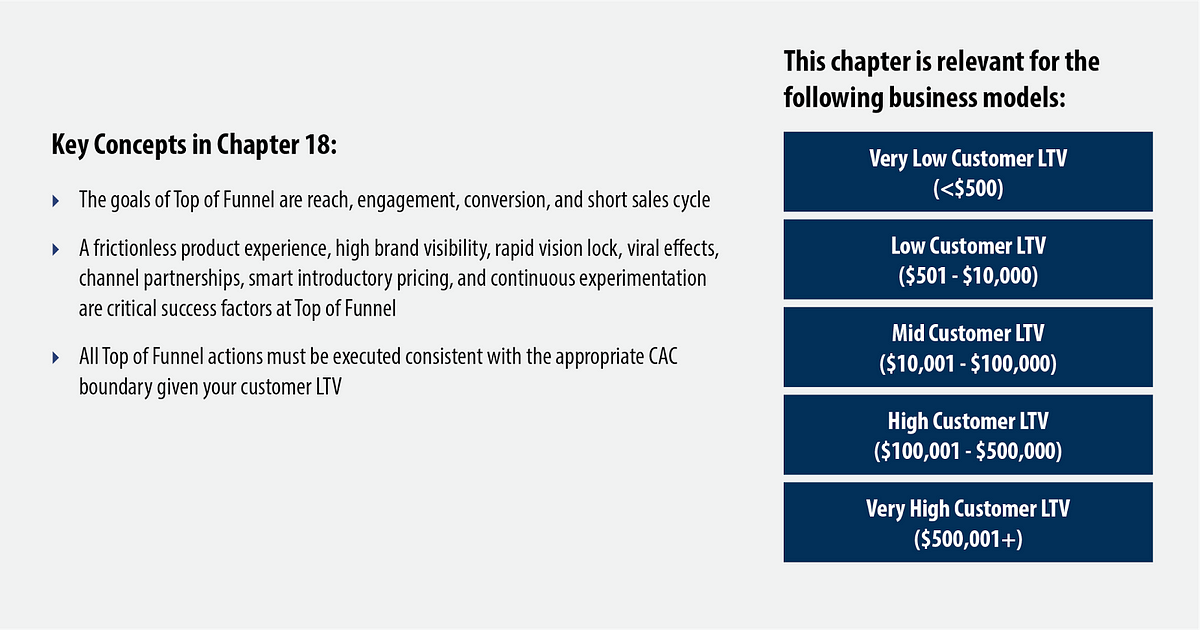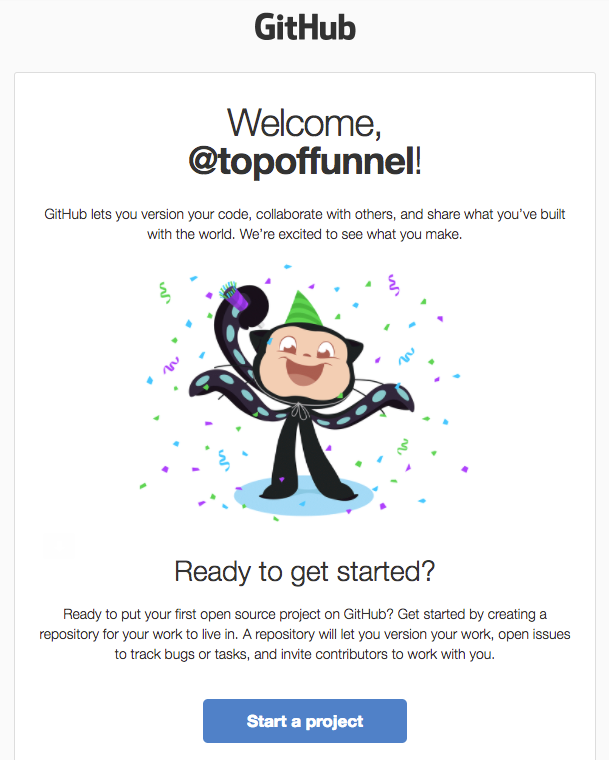At Top of Funnel, you tackle the total addressable market.

This chapter concerns the Top of Funnel domain of the Bow Tie:

At Top of Funnel, you must quickly gain vision lock with your prospect (“I get what you do and why it’s relevant for me”). Four objectives should drive your plan: to maximize reach, to achieve rapid product engagement, to maximize conversion, and to shorten the sales cycle. You must meet all of these objectives within an acceptable cost boundary given customer LTV.
Customer LTV is always the best way to describe a company’s business model. The CAC you have available given your LTV determines your choice of customer acquisition tactics.
Even though the money you can spend per customer at Top of Funnel varies dramatically from the Very Low LTV business model to the Very High LTV business model, the primary levers are consistent:
- Frictionless product experience: A lightweight, addictive, easy on-ramp product experience that maximizes engagement as close to Top of Funnel as possible
- Maximize brand and product visibility: Within the constraints of your business model, maximize connections with prospects — optimizing for reach, frequency, and diversity of touch points
- Speed to vision lock: In all messaging, leverage your value proposition and competitive positioning to maximize speed to vision lock — the point at which prospects declare, “I get what you do and why it’s relevant for me.”
- Viral effects: In the orchestration of Top of Funnel actions, maximize likelihood of social sharing and encourage community building
- High-affinity channel partnerships: The right channel partners bring you established relationships in top priority segments delivering both access and credibility
- Frictionless pricing: Reduce risk and incentivize trial via introductory pricing (your business model will govern whether it’s free forever, freemium, free trial, or proof-of-concept)
- Data-driven continuous improvement: At Top of Funnel, ongoing experimentation is the imperative — in product, pricing, messaging, content formats, and content distribution channels. Instrument metrics into everything, and ensure your teams use metrics to test, iterate, and optimize on a continuous basis
CAC should be no more than ⅓ LTV
For a media company, where the LTV of a unique consumer could be as low as 2 cents, only ⅓ of that LTV (in this example, 6/10ths of a cent) is available to spend per new consumer. Given this extremely low CAC investment threshold, the product experience is king. This “first mile” (to use Scott Belsky’s terminology) must immediately capture the user’s interest and spark instant engagement. The Very Low LTV business model heavily depends on viral effects. Channel partnerships are one viable option to expand reach. If CAC investments are viable at all, these are fully digital and highly cost efficient.
For a gaming company with a subscription model, there may be more room to invest in CAC. An annual pass for the game World of Warcraft costs about $150; if we assume 90% gross margin and a three year average life, a new customer has an LTV of $405. So using the principle that LTV / CAC should be at least 3, World of Warcraft can spend up to $135 to acquire a new customer.
Take the case of a B2B SaaS business selling to SMB customers with a $21,000 LTV. The CAC boundary (in this case, $7000) might support strong performance marketing at the Top of Funnel, with a high-velocity lead-conversion call center at the bottom. This works only if the product is instantly compelling and the demo draws the prospect into active use.
At the high end of the LTV continuum, a B2B enterprise software company with average customer LTV over $500,000 can spend over $150,000 per acquired customer, enabling a comprehensive, customized, multi-dimensional account-based sales model. At Top of Funnel, highly customized content and thought leadership (sometimes customized down to the individual prospect level), combined with highly personalized 1:1 outreach (to buyers, users, and influencers) makes sense. Multi-touch engagement includes both digital and human forms, with multiple players in your company engaging with multiple players at the target account in a highly orchestrated Top of Funnel plan. Even here, it’s best to bring the product as close to the top of the funnel as possible — to give the prospect a tantalizing glimpse into the product experience.
Frictionless Product Experience
It might seem unusual to start a Top of Funnel strategy discussion with product considerations. But indeed it’s exactly the right place to start. Regardless of your business model, the closer you can draw your product to the Top of the Funnel, the better. Product is perhaps the most potent Top of Funnel lever of all.
For Very Low LTV business models — media companies, game companies, B2C marketplace companies, B2C e-commerce companies, etc. — the “first mile” of the product experience is everything. It’s all about the immediate delivery of recognizable value. Does a first-time user instantly encounter value-creating content? Is early product engagement friction free? When the user is asked to provide data (such as personal information), is it minimal, and is the quid pro quo instantaneous and high-value? Very Low LTV business model companies have no choice but to figure these things out.
Every other business model — from Low to Mid to High to Very High LTV — can learn a lot from Very Low LTV companies. Jim Goetz and other partners at Sequoia Capital contributed to the online book, The Templeton Compression and the Sales Ready Product,¹ introducing the idea of the Sales Ready Product (SRP). Goetz et al. argue that minimum viable product (MVP) is not enough. Trying to scale with an MVP yields an excessively long sales cycle with too much human effort required to lead the prospect to proof of value. To shorten sales cycles, increase win rates, and leverage sales investments, companies should invest more time and development cycles to turn the product into an SRP.

Source: Sequoia Capital, The Templeton Compression and the Sales Ready Product
Fellow CEO Quest Managing Partner Bill Portelli points out in a compelling paper, “The Sales Ready Product: Compressing B2B Sales Cycles — Part 1”² that building the SRP must be a top cross-functional company priority. He references the example of GitHub, which used a public cloud based approach to disrupt the software configuration management market. To start using GitHub, a user only enters their username, email address, and password, followed by the name of a project. Just four clicks and you’re up and running. Here’s a promotional email that highlights this immediate product experience:

Source: GitHub nurture email, May 2017
Contrast that with competitors that require a company to install enterprise grade versioning software on-site. One cloud tool that competes with GitHub requires as many as two dozen clicks to get up and running. In both cases, the competitor is at a huge disadvantage compared to GitHub.
To build the SRP, product and engineering must work in close collaboration with sales and marketing. Deep research into the needs and personas of your top priority segments is required. You need a list of top objections and a list of the most desired features. These are the raw materials that allow you to create a “first mile” experience focused on maximizing immediate conversion. Scott Belsky’s work, “Crafting The First Mile of Product,”³ provides an excellent summation of the critical design considerations to address in the early user experience.
In an SRP, a high-value product utility is presented at Top of Funnel. The utility’s purpose is to deliver what Goetz calls a “light switch moment” — when the potential value of the product becomes instantly apparent. The prospect is encouraged to enter real data into the utility and immediately experiences value.
For B2B products, such a utility could embed a self-serve ROI calculator. A Mid LTV product might push out four or five different product utilities addressing different market segments or use case scenarios. Each creates a unique entry point based on segment-specific value drivers, but all are designed to deliver rapid speed to value — to give a tantalizing glimpse into the full product’s capabilities. Prospective buyers and users can play with these utilities on their own at the top of the funnel, or experience them during the demo.
For Low LTV business models, the utility might be entirely self-serve. For Mid, High, and Very High LTV business models, customers might enter real data into the product platform during a demo. Regardless of business model, the idea is to push the product as close to Top of Funnel as possible.
Goetz’s rule of thumb for Mid to High LTV B2B companies is to continue working on the SRP until you can consistently achieve a 50% close rate within 30 days. The proof is in the pudding: if you haven’t hit that level of sales performance, your product is not yet an SRP.
Maximize Brand and Product Visibility
For your company to be successful, it must first be known. Brand awareness is a key objective at Top of Funnel. As buyers and users within your top priority segments wrestle with the problems your product can solve, your brand must come to mind — or you’ll never win in the marketplace.
Brand awareness starts with strategy. Are you creating a new market (seeking to change paradigms) or disrupting an existing market (seeking to change buyer behavior)? The levers available to you in building brand awareness include thought leadership, brand campaigns, performance marketing campaigns, events, channel partnerships, and direct account-based marketing and sales. But how you use these levers is based on your strategy, business model, and competitive dynamics which you use to weigh Top of Funnel awareness options:

Let’s say you’re creating a new market. That means you must evangelize a revolutionary, paradigm-changing technology. To do that, you must answer two questions:
- Why do you matter?
- Why now?
When Lightbend built its reactive application development platform, it was working at the edge of innovation. Enterprises were just beginning to confront the problems created by the decentralized, multi-device, spiky-data, cloud-based world we live in today. The whole idea of microservices-based architecture was in its infancy. To break through, Lightbend needed to evangelize a movement. In 2014, Lightbend’s CTO, Jonas Boner, co-authored The Reactive Manifesto,⁴ laying out the core principles of the Reactive movement. Since its release, the manifesto has garnered over 19,000 signatures. And so a community was born.
Lightbend and key team members continue to be prominent and prolific thought leaders, authoring a steady stream of compelling content to serve this rapidly expanding tech community. Not only does the content feed the movement, but it also catches the attention of the largest players in the ecosystem. Today, Lightbend is widely considered to be at the forefront of this fundamental shift in information technology.
Some companies must change paradigms. But all companies must change buyer behavior if they are to be successful. For this to happen, you must build the brand, evangelize the product, demonstrate competitive advantage, and execute calls to action.
These Top of Funnel imperatives put us into the world of brand marketers, product marketers, and growth marketers. The brand marketer’s job is to build brand equity. The product marketer’s job is to create product-related content. And the growth marketer’s job is to test, iterate, optimize, and scale campaigns.
There are many tools in the toolkit. Variations in content purpose combine with variations in content format, content type, content delivery methods, and delivery platforms to create a wide array of choices:
Content purpose
- Thought leadership
- Public relations
- Brand development
- Demand generation / performance
Content format
- Press releases
- Articles
- Slideshows
- Videos
- E-books
- Photos
- Blog posts
- Printed material
Content type
- Curation
- “How to”
- Reviews
- Interviews
- Quizzes
- Best practices
- Testimonials
Delivery method
- Organic search
- Paid search
- Display / retargeting
- Social advertising
Delivery platform
- Company website
- Facebook / YouTube / Twitter and other social sharing platforms
- Blog sites
- Forums
- Events
Your messaging schema (with its brand, product marketing, and growth marketing playbooks) is your guide for all Top of Funnel content creation. Everything you create must be true to your brand identity. Within those guidelines, your goal is to maximize reach and impact.
Speed to Vision Lock
Speed to vision lock (“I get what you do and why it’s relevant for me.”) is a function of sharp, lucid competitive positioning. Excellent positioning instantly communicates your value proposition in a way that boxes in your competitors (see Chapter 6 — Competitive Positioning). Top of Funnel messaging must deliver instant vision lock. Get to the “aha” moment as quickly as possible. If you don’t, prospects simply won’t spend time seeking to understand — they’ll just move on.
Remember that all roads lead to the company website. So the website itself must present content that quickly moves the visitor towards a frictionless, high-value initial product experience. You want prospects to find instant product value, dig deeper, gain confidence, and move from “interest” to “lead” to “closed won” as efficiently as possible.
Viral Effects
To maximize the impact value of content you must focus not only on initial consumption, but also on total available reach. Online social sharing becomes a force multiplier. But isn’t virality, by definition, out of your hands? Not at all. The key is to construct your content with sharing in mind. Known sharing triggers include “funny,” “cool,” “shocking,” “controversial,” “illuminating,” and “uplifting.” In fast-scaling best-practice companies, the content calendar is filled with content plans across multiple content formats, using multiple content types, leveraging all significant content platforms, with liberal use of the sharing triggers to increase engagement. Not everything will go viral — but if you’re intentional about it, some of your content will.
Channel Partnerships
Channel is a powerful Top of Funnel tool (see Chapter 11 — Channel Architecture).
A channel partnership can transform a company, regardless of its business model.
This is exactly what happened to CareerBuilder when it won the AOL and MSN deals away from Monster.
Channel partnerships can be equally transformational for companies with higher LTV business models. Siebel’s Andersen Consulting and IBM partnerships propelled them to global status. In both cases, these partnerships opened doors to thousands of new prospects that otherwise would have been more challenging and expensive to reach.
Frictionless Pricing
Introductory pricing is another key Top of Funnel tool (see Chapter 9 — Pricing and Packaging). The objective is to reduce perceived risk so as to accelerate the transition from prospect to customer. There are four variations:
- Free forever
- Freemium
- Free trial
- Proof of concept
Most media models keep the consumer experience free forever, in return for accepting ads on the page. By minimizing visitor friction, media sites hope to maximize visitor growth, then monetize via display advertising on a cost per thousand (CPM) basis.
Freemium models are most common in Low LTV B2C offerings such as gaming and Low to Mid LTV B2B SaaS, where users can use the product for free up to a certain usage threshold. Once usage rises above the defined threshold, users must pay.
A free trial is a widely used pricing method to reduce introductory risk, especially for B2B SaaS offerings. Here, the customer self-provisions and is free to use the product for a short period. When a frictionless initial product experience is paired with a sales ready product (SRP), it can be a powerful Top of Funnel pricing strategy.
For High and Very High LTV products, a free trial is often not feasible. The launch cost is too high. Even so, the objective to minimize risk remains a priority. Here, a proof of concept (POC) approach often makes sense. The customer pays for a single-purpose implementation, contracted to be live for a limited time. Once again, the POC reduces friction, and the offer of a POC, along with an SRP, can be built into Top of Funnel messaging.
Data-Driven Continuous Improvement
What are the three most essential competencies to possess for strong Top of Funnel execution? Analytics, analytics, analytics.
With Very Low LTV business models, acceleration requires (and the volume of data allows) a highly quantified, analytical approach. All fast-growing companies with Very Low LTV business models have developed strong competencies in analytics. These days, many vendors deliver advanced analytical capability. For instance, QuanticMind helps marketers optimize their search and social investments, algorithmically guiding ad buys by manipulating such variables as keywords, time of day, and even geography. The results can be profound in reducing cost per lead at scale.
As you move up the LTV continuum, data must continue to be at the center of Top of Funnel optimization, although as data volume declines statistical reliability does too.
Include on your team at least one data geek with access to the tools and instrumentation necessary to conduct analyses. At Top of Funnel, analytical rigor must be a core competency and a daily discipline.
For Mid, High, and Very High LTV business models, the yield from effective product and growth marketing is steadily growing MQL volume, captured at an efficient acquisition cost. Efficiency is achieved by minimizing cost and maximizing conversion which, of course, requires that you continuously test, iterate, and optimize.
Top of Funnel constitutes the frontline of the battle to survive, scale, and dominate.
Fight intelligently.
. . .
Notes:
- Sequoia Capital, Jim Goetz & others. The Templeton Compression and Sales Ready Product. Online book. Inkling.com, 2015.
- Bill Portelli. “The Sales Ready Product: Compressing B2B Sales Cycles — Part 1.” Special Report. CEO Quest. Medium.com, November 2017.
- Scott Belsky. “Crafting the First Mile of Product.” Blog post. Positive Slope. Medium.com, June 2016.
- Jonas Boner. “The Reactive Manifesto.” Post on website. reactivemanifesto.org. September 2014.
. . .
If you would like more CEO insights into scaling your revenue engine and building a high-growth tech company, please visit us at CEOQuest.com, and follow us on LinkedIn, Twitter, Facebook, and YouTube.

